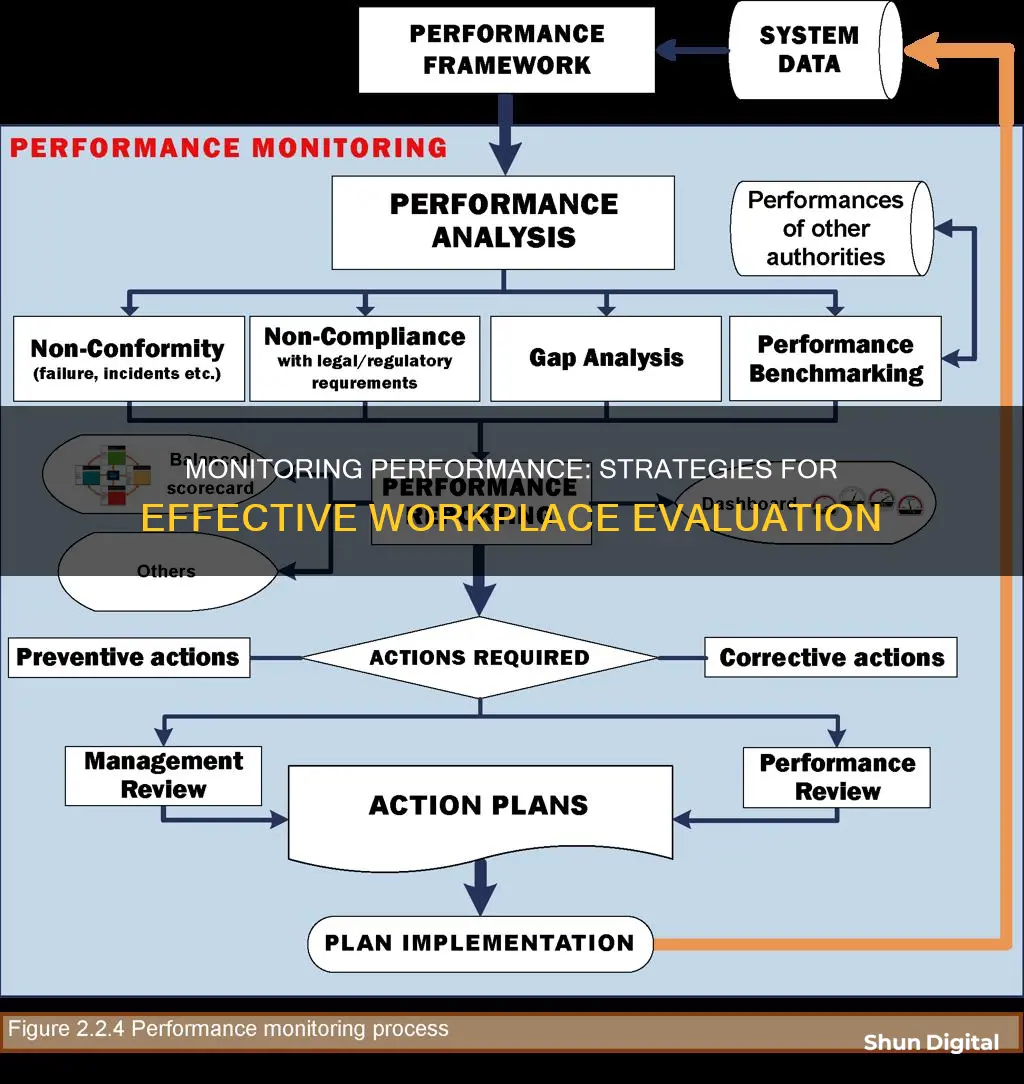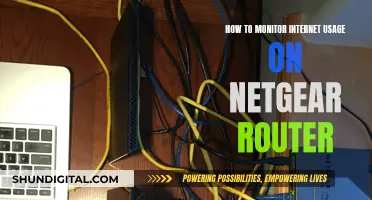
Monitoring employee performance is an important aspect of management. It helps identify areas of improvement, drives business success, and ensures employees are aligned with organisational goals. While it can be challenging for managers to balance monitoring with their own workload, it is essential to keep track of employee performance to provide feedback, address concerns, and improve productivity. This can be achieved through various methods such as regular check-ins, performance management software, employee monitoring software, peer reviews, self-monitoring tools, and more. By utilising these strategies, managers can effectively evaluate employee performance, provide valuable feedback, and create a positive work environment that fosters growth and success.
What You'll Learn

Regular check-ins and one-on-one meetings
To make the most of these meetings, there are several strategies that can be employed:
Set Clear Goals
Before meeting with employees, it is important to set clear and relevant goals. These goals should be specific, measurable, aligned with business objectives, realistic, and timely. By setting clear goals, employees will have a better understanding of what is expected of them and can work towards achieving those goals.
Ask for an Account of Employee Actions
During one-on-one meetings, ask employees for an account of their actions since the last meeting. Enquire about the concrete steps they have taken and whether they have met the expectations set. This helps to hold employees accountable for their actions and ensures that they are on track.
Provide Performance Feedback
Use these meetings as an opportunity to provide valuable feedback to employees. Share both positive and negative aspects of their performance and be direct when providing constructive criticism. Offer specific examples and advice on how they can improve. Recognise and reward employees for their achievements to boost morale and motivate them to continue performing at a high level.
Discuss Concerns and Provide Support
Check-ins are also a chance for employees to voice any concerns or challenges they are facing. As a manager, it is important to listen actively and provide support or guidance where needed. This shows that you care about their well-being and are invested in their success.
Establish Regular Communication
Consistency is key when it comes to check-ins and one-on-one meetings. By scheduling these meetings at regular intervals, you create a routine that helps employees know what to expect and allows for ongoing performance monitoring. This also provides an opportunity to identify any issues early on and prevent them from becoming bigger problems.
In addition to these strategies, it is important to adapt your approach based on the specific needs and dynamics of your team. Regular check-ins and one-on-one meetings are a powerful tool for monitoring employee performance and fostering a positive and productive work environment.
Recognizing HD Monitors: What to Look For
You may want to see also

Performance management software
There are various software options available, such as Deel, Mitratech Trakstar, Performance Pro, and ClearCompany, each offering unique features. For example, Deel integrates with popular HR software and offers a free version for small businesses, while Mitratech Trakstar provides an easy-to-use interface and accommodates volume-discount pricing. Performance Pro allows for tracking of individual competencies, and ClearCompany provides an automated solution for performance reviews.
When choosing performance management software, it is essential to consider the specific needs of your business. Key features to look for include user-friendliness, customisability, regular feedback capabilities, employee development plan support, 360-degree feedback, performance metrics and key indicators, and integration with other systems. Additionally, pricing is an important factor, with costs varying depending on the features, integrations, and number of users.
By implementing performance management software, businesses can improve employee engagement, satisfaction, and retention. It provides a structured approach to evaluating and enhancing employee performance, aligning individual goals with organisational objectives. The software enables managers to identify areas of improvement and make informed decisions regarding training, promotions, and succession planning.
Monitoring Bandwidth Usage: Android Tips and Tricks
You may want to see also

Self-monitoring tools
- Project plans: Employees can use project plans to outline the steps they need to take to complete a project and set deadlines for each step. This helps them stay organized and on track.
- Checklists: A checklist is a simple but effective way to ensure that all tasks are completed. Employees can create checklists for each project or task, listing all the steps that need to be taken and checking them off as they are completed.
- Activity logs: Activity logs are like diaries that employees keep to record their daily activities, including breaks and interruptions. This helps them track how they spend their time and identify any areas where they may be wasting time.
- Time-tracking software: There are many software programs that can help employees track the time they spend on different tasks. For example, TimeDoctor has an informative dashboard for analysing employee productivity and monitoring project completion.
- Performance management software: This type of software can help employees set and track goals, and provide a centralised system for monitoring their progress. For example, Deel is a comprehensive HR platform that offers performance management tools, including the ability to facilitate ongoing feedback and performance discussions.
Adjusting Your Monitor: Finding the Perfect Brightness
You may want to see also

360-degree feedback
When implementing a 360-degree feedback system, it is important to consider the following:
- Engage all relevant stakeholders: Obtain buy-in from senior decision-makers and ensure participation in the process and action plans.
- Define success: Clearly communicate the criteria for measuring the success of the 360-degree feedback program to all stakeholders.
- Create urgency and offer rewards: Set clear deadlines for feedback submission and consider providing incentives to encourage participation.
- Plan follow-ups: Ensure that the 360-degree feedback is not a stand-alone event by incorporating follow-up activities and stimulating employees to take action on the feedback.
- Consider development vs evaluation: If the goal is personal development, individuals should be able to select their raters. If the goal is performance evaluation, raters should be chosen based on how closely they work with the individual.
- Integrate goals and competencies: Focus the evaluation on competencies critical to the individual's job and the organisation's success.
- Ensure credible data: Obtain feedback from a sufficient number of raters who are familiar with the individual being evaluated.
- Foster accountability: Create follow-up processes with managers or coaches to help individuals act on the feedback and work towards behavioural change.
- Achieve census participation: Given the labour-intensive nature of 360-degree feedback, management must set clear expectations, be accountable for the process, and promote a culture of consistency and fairness.
Additionally, when designing a 360-degree feedback questionnaire, it is important to select competencies relevant to the individual's function and define specific behaviours or dimensions for each competency. The questionnaire should also include open-ended questions that allow raters to provide more detailed feedback. Overall, 360-degree feedback can be a valuable tool for employee development, but it should be implemented carefully to ensure its effectiveness and avoid potential challenges.
Connecting the GA-970A-DS3P EX to a Monitor: A Step-by-Step Guide
You may want to see also

Monitoring employee performance throughout the year
Regular Check-Ins and One-on-One Meetings:
Encourage team leaders to schedule regular check-ins and one-on-one meetings with employees. These meetings provide a casual format to discuss progress, address concerns, and offer guidance. They help maintain transparency, foster positive working relationships, and ensure employees and managers are aligned before year-end reviews.
Performance and Employee Monitoring Software:
Utilize performance management software to streamline the monitoring process and make it more efficient. These tools help set goals, track progress, and centralize employee performance data. Additionally, consider implementing employee monitoring software to gather hard data on employee performance while maintaining their privacy.
Peer Reviews and 360-Degree Feedback:
Incorporate peer reviews and 360-degree feedback to gain insights from multiple perspectives. 360-degree feedback involves evaluations from colleagues, subordinates, and managers, providing a holistic view of an employee's strengths and areas for improvement.
Self-Reported Surveys:
Ask employees for their perspective through self-reported surveys. While engagement measurement tools exist, hearing directly from employees can significantly improve engagement and provide insights into their performance and understanding of company goals. Ensure that surveys are carefully designed to elicit honest and informative responses.
Visual Monitoring and Spot-Checking:
For in-person teams, visual monitoring can provide quick insight into employee performance and attitudes. Make rounds throughout the day to gauge attitudes and spot potential issues. Regularly shadow employees for longer periods to identify inefficient habits or weak skills. For remote teams, consider using task management software to track progress and performance.
Communication and Feedback:
Communicate regularly with employees to understand their needs, address concerns, and provide feedback. Organize one-on-one meetings to discuss challenges, goals, and performance. Ask open-ended questions to encourage honest dialogue and create a supportive environment.
Performance Evaluation and Goal Setting:
Create performance files for each employee, documenting their successes and mistakes. Analyze employee productivity throughout the year using detailed reports to identify areas of improvement. Set relevant goals and milestones for employees, following the SMART framework (Specific, Measurable, Aligned, Realistic, and Timely).
Recognition and Rewards:
Recognize and reward employees for their achievements. This can be done through appreciation, sharing client praise, or offering gifts cards, paid trips, or other incentives.
Remember to maintain a balance between monitoring and trust, especially with remote work. Ensure you comply with data protection regulations and be transparent with employees about the type and frequency of monitoring.
Connecting Your PlayStation 4 to a Monitor: A Guide
You may want to see also
Frequently asked questions
There are several ways to monitor your employees' performance. Firstly, you could watch them work. This can be done in person or remotely through video calls, screen sharing, or remote-access programs. Secondly, you could ask your employees to provide an account of their work and the steps they took to complete tasks. Thirdly, you could use performance management software or employee monitoring software to track their progress and performance. Finally, you could ask customers, vendors, coworkers, and other managers about their interactions with specific employees.
Monitoring employee performance can help to improve productivity and employee satisfaction. It can also help managers identify areas where employees may need additional training or support. Additionally, it can help organisations identify areas for improvement in processes or resource allocation.
There are a few ways to monitor remote employees' performance. One way is to use task management software, which can help you track the progress and performance of your employees. Another way is to implement self-monitoring tools such as project plans, checklists, and activity logs. Additionally, you can use employee monitoring software to track their activity and productivity.
It is recommended to monitor employee performance regularly and consistently. This can be done through weekly or daily check-ins, stand-up meetings, or one-on-one meetings. It is also important to conduct an annual employee performance evaluation to review both employees' strengths and weaknesses and provide valuable feedback.







